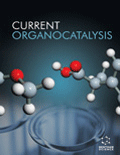- Home
- A-Z Publications
- Current Organocatalysis
- Previous Issues
- Volume 6, Issue 2, 2019
Current Organocatalysis - Volume 6, Issue 2, 2019
Volume 6, Issue 2, 2019
-
-
Metal Nanoparticles: An Efficient Tool for Heterocycles Synthesis and Their Functionalization via C-H Activation
More LessAuthors: Debasree Saha and Chhanda MukhopadhyayBackground: Metal nanoparticles have been extensively used in the synthesis of organic molecules during the last few decades especially due to their high catalytic activity. Organic reactions involving C-H functionalisations are very much in demand as they provide a direct method of derivatisation of organic molecules, thus making the process economical. In the recent years, metal nanoparticles catalysed C-H activati Read More
-
-
-
Organocatalysis: Trends of Drug Synthesis in Medicinal Chemistry
More LessAuthors: Biswa M. Sahoo and Bimal Krishna BanikBackground: The continuous increase in challenges associated with the effective treatment of life threatening diseases influences the development of drug therapies with suitable physicochemical properties, efficiency and selectivity. So, organocatalysis is a potential synthetic tool which is accelerating the development of new drug molecules. Methods: Organocatalysis reactions can be carried out at lower temperatures an Read More
-
-
-
Assessment of Chitosan Based Catalyst and their Mode of Action
More LessAuthors: Dipika Pan and Jhuma GangulyIntroduction: The popularity of chitosan is increasing among the researchers due to its environment friendly nature, high activity and easy approachability. Chitosan based catalysts are not only the most active and selective in catalytic reaction, but their “green” accessibility also makes them promising in organic catalysis. Chitosan is commonly extracted from chitin by alkaline deacetylation and it is the second abundant Read More
-
-
-
Azoimine Chelated Ruthenium(II)- and Osmium(II)-Carbonyl Complex Catalyzed Alcohol Oxidation Reaction
More LessArylazoimidazole brings azoimine (-N=N-C=N-) chelating N(azo), N(imine) (abbreviated - N, N/) centres and forms Ru(II) and Os(II) carbonyl complexes. These complexes act as catalysts for the oxidation of alcohols to aldehydes/ketones by tertiary butyl hydro peroxide (ButOOH), hydrogen peroxide (H2O2) and N-methylmorpholine-N-oxide (NMO) as oxygen sources. Different substituted arylazoimidazoles such as 1 Read More
-
-
-
Baker’s Yeast-Based Organocatalysis: Applications in Organic Synthesis
More LessAuthors: Biswa M. Sahoo and Bimal Krishna BanikBackground: Catalyst speeds up any chemical reaction without changing the point of the equilibrium. Catalysis process plays a key role in organic synthesis to produce new organic compounds. Similarly, organocatalysis is a type of chemical catalysis in which the rate of a reaction is accelerated by organic catalysts. Methods: Organocatalysts have gained significant utility in organic reactions due to their less of sensiti Read More
-
-
-
Asymmetric Direct Aldol Reaction Catalyzed by (1R, 2R)-(+)-1, 2-Diammonium Cyclohexane-L-tartrate in Water
More LessAuthors: Anirban Mondal and Kartick C. BhowmickBackground: A cheap and commercially available organocatalyst, (1R, 2R)-(+)-1, 2- diammonium cyclohexane-L-tartrate 1 was applied in direct aldol reaction in water. The organocatalyst 1 afforded aldol products from cyclohexanone and substituted aromatic aldehydes with high yield (up to 90%) and good stereoselectivity (up to 99% ee and up to 11.5:1 dr) in large volume of water (10 ml). Methods: The same aldol reaction Read More
-
-
-
Synthesis of 1,2-Diamine Bifunctional Catalysts for the Direct Aldol Reaction Through Probing the Remote Amide Hydrogen
More LessAuthors: Rajasekhar Dodda, Sampak Samanta, Matthew Su and John Cong-Gui ZhaoBackground: While proline can catalyze the asymmetric direct aldol reactions, its catalytic activity and catalyst turnover are both low. To improve the catalytic efficiency, many prolinebased organocatalysts have been developed. In this regard, prolinamide-based bifunctional catalysts have been demonstrated by us and others to be highly efficient catalysts for the direct aldol reactions. Results: Using the β-acetamido- and β- Read More
-
-
-
[AcMIM]FeCl4: A Magnetically Separable Organocatalyst for the Clean Synthesis of Tetrahydrobenzo[b]pyran Derivatives
More LessAuthors: Arijit Saha, Soumen Payra, Archana Asatkar, Ashok R. Patel and Subhash BanerjeeBackground: Recently, organic synthesis using ionic liquids (ILs) via green approach has attracted considerable attention to address the problem associated with environmental pollution. Magnetization of ILs provides added advantages of separation by external magnet. This can be accomplished by incorporation of high-spin iron(III) in the form of tetrachloro or tetrabromoferrate( III). Thus, synthesis of novel magnet Read More
-
Most Read This Month
Article
content/journals/cocat
Journal
10
5
false
en

Most Cited Most Cited RSS feed
-
-
Liquid Membranes in Catalysis
Authors: Muhammad W. Ashraf and M. Amin Mir
-
- More Less

